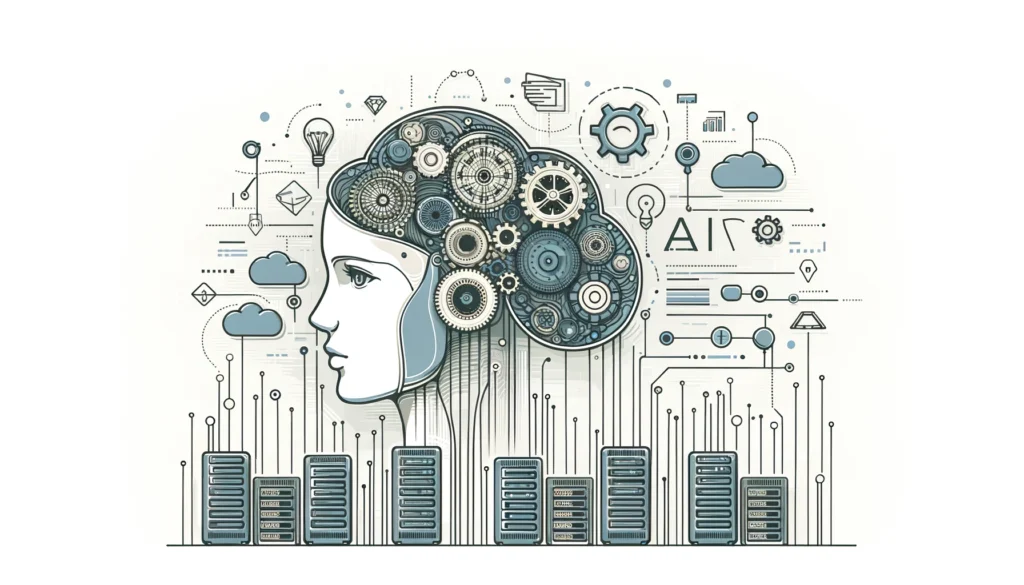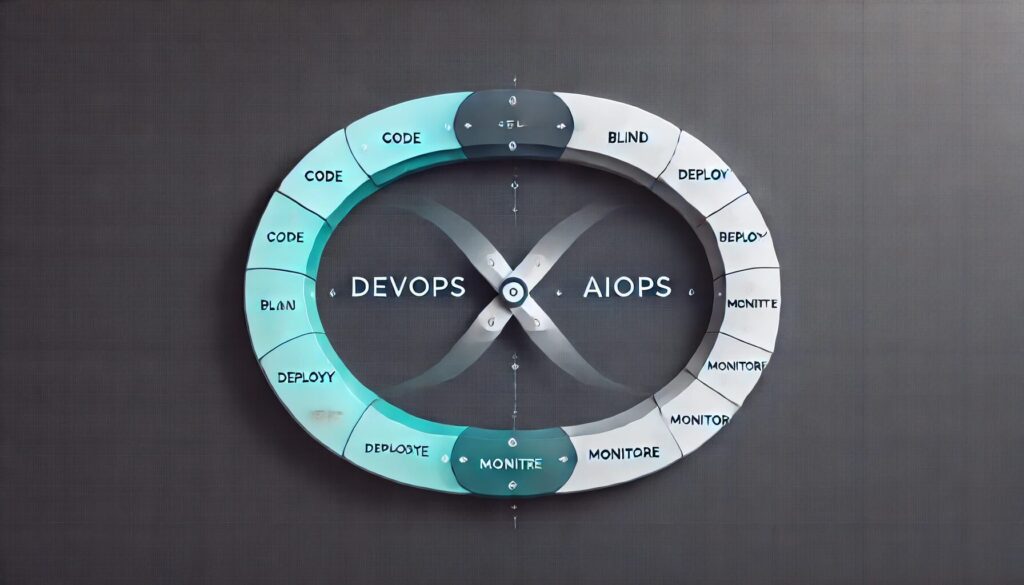
AIOps (Artificial Intelligence for IT Operations) is not just another buzzword—it’s a transformative technology reshaping how organizations manage their IT infrastructure. Coined by Gartner, AIOps leverages AI, machine learning (ML), and big data to enhance and automate IT operations. This evolution is crucial as modern IT ecosystems become increasingly complex, with hybrid and multi-cloud environments becoming the norm.
The Strategic Evolution of AIOps: Beyond Automation
AIOps was initially conceived as a solution to manage the growing complexity of IT systems through automation. However, in 2024, AIOps has transcended its original purpose. It is now a strategic tool that not only automates but also optimizes and enhances IT operations. This evolution is characterized by its ability to integrate machine learning, big data analytics, and artificial intelligence to provide actionable insights, predict system failures, and even initiate autonomous remediation.

AIOps in 2024: Key Trends Shaping the Future
1. Hyper-Automation: Beyond Traditional Automation
The concept of hyper-automation has gained significant traction in 2024, marking a departure from traditional automation. Hyper-automation in AIOps involves automating every aspect of IT operations, including decision-making processes that were previously manual. This trend is driven by advancements in AI and machine learning algorithms that allow for the automation of complex, cognitive tasks. Businesses are leveraging hyper-automation to reduce operational costs, minimize human error, and improve overall system reliability.
- Real-World Example: Consider a large financial institution that uses AIOps for hyper-automation. By automating tasks such as fraud detection, network monitoring, and customer service inquiries, the institution not only improves efficiency but also enhances customer experience and compliance with regulations.
2. Predictive Maintenance and Anomaly Detection: The New Normal
In 2024, predictive maintenance has moved from being a cutting-edge capability to a standard expectation in IT operations. AIOps platforms now come equipped with sophisticated predictive analytics that can forecast potential system failures before they occur. This shift is largely due to advancements in machine learning that allow AIOps systems to analyze vast datasets in real-time, identifying patterns and anomalies that could lead to downtime or performance degradation.
- Deep Dive: Modern AIOps solutions use unsupervised learning algorithms to detect anomalies that might not fit predefined patterns, making them particularly effective in complex, dynamic environments. These systems can correlate events across different data sources, providing a holistic view of IT health and enabling proactive maintenance.
3. Seamless Integration with DevOps: Bridging the Gap
The integration of AIOps with DevOps practices has become a critical factor in 2024. This synergy enhances the DevOps pipeline by providing real-time insights into application performance, security vulnerabilities, and system stability. AIOps automates routine tasks such as code testing, deployment monitoring, and incident management, allowing DevOps teams to focus on innovation rather than maintenance.
- Strategic Impact: This integration also shortens the feedback loop between development and operations, enabling faster, more reliable software delivery. Organizations that successfully integrate AIOps with DevOps can achieve continuous integration and continuous deployment (CI/CD) with greater efficiency and reduced risk.
Overcoming Challenges in AIOps Adoption
4. Data Overload and Quality Management: The Foundation of AIOps
The effectiveness of AIOps hinges on the quality of the data it processes. However, many organizations struggle with data overload and poor data quality, which can lead to inaccurate insights and flawed decision-making. In 2024, there is a growing emphasis on data governance and quality management as foundational elements of successful AIOps implementation.
- Advanced Solutions: Organizations are adopting data cleansing techniques and real-time data validation to ensure that their AIOps systems are fed with high-quality data. Additionally, data integration platforms are being used to harmonize data from disparate sources, providing a unified view of the IT environment.
5. Addressing the Skill Gap: Building the AIOps Workforce
As AIOps technology becomes more advanced, there is a widening skill gap in the market. In 2024, organizations are taking proactive steps to address this challenge by investing in upskilling their workforce and adopting AI-driven tools that simplify AIOps deployment.
- Workforce Development: Companies are launching specialized training programs and certification courses to build the necessary skills within their teams. Additionally, AI-driven platforms with low-code or no-code capabilities are making it easier for IT professionals to implement AIOps without deep technical expertise.

Practical Applications and Use Cases of AIOps
As AIOps becomes more sophisticated, its applications are expanding across various domains within IT operations. Here are some of the most impactful use cases in 2024:
Incident Management: Faster Detection and Response
AIOps has revolutionized incident management by enabling faster detection and response times. By automating the initial diagnosis of incidents, AIOps platforms can reduce the time it takes to identify and mitigate issues. For instance, if a server experiences a heavy load, an AIOps platform can automatically trigger a load balancer or spin up additional resources to maintain service availability.
- Key Benefits: This automation not only accelerates incident resolution but also reduces the impact on end users, maintaining system uptime and performance.
Capacity Planning: Forecasting and Optimization
Capacity planning is another critical area where AIOps is making a significant impact. By leveraging predictive analytics, AIOps platforms can forecast resource requirements based on historical data and upcoming demand patterns. This capability helps organizations avoid resource shortages and optimize their infrastructure investments.
- Strategic Advantage: Effective capacity planning with AIOps ensures that organizations can scale their operations seamlessly, supporting growth without over-provisioning resources, which can lead to unnecessary costs.
Security Operations: Enhancing Threat Detection
In 2024, security operations are increasingly relying on AIOps to detect and respond to security threats. AIOps platforms can analyze vast amounts of data to identify unusual patterns or behaviors that might indicate a security breach. This capability enhances the overall security posture of organizations by enabling faster threat detection and response.
- Security Impact: By automating threat detection, AIOps reduces the window of vulnerability, allowing IT teams to address potential security incidents before they escalate into major breaches.
Performance Monitoring: Real-Time Insights
Performance monitoring is a fundamental aspect of IT operations, and AIOps is elevating this practice to new heights. AIOps platforms continuously monitor system performance, providing real-time insights that allow IT teams to maintain optimal performance levels. When performance degradation is detected, AIOps can automatically adjust system parameters or trigger alerts for human intervention.
- Operational Efficiency: This real-time monitoring and response capability ensures that IT systems operate at peak efficiency, reducing downtime and improving user experience.
Root Cause Analysis: Precision and Speed
Root cause analysis is traditionally a time-consuming process that requires correlating data across multiple systems. AIOps enhances this process by automating data correlation and analysis, allowing IT teams to identify the underlying cause of an issue more accurately and faster than ever before.
- Problem Resolution: Faster root cause analysis leads to quicker problem resolution, reducing the time systems are down and minimizing the impact on business operations.

The Future of AIOps: Towards Autonomous IT Operations
The ultimate goal of AIOps is to enable autonomous IT operations—systems that can manage, optimize, and heal themselves with minimal human intervention. In 2024, we are witnessing the early stages of this transformation. AIOps systems are now capable of self-healing, self-optimizing, and self-scaling based on real-time data and predefined parameters.
- Future Outlook: As AIOps technology continues to evolve, we can expect these autonomous capabilities to become more robust, allowing IT systems to respond to incidents in real-time, optimize resource allocation dynamically, and scale operations to meet changing demands without human intervention.
Common Questions About AIOps in 2024
What is AIOps and why is it important?
AIOps, short for Artificial Intelligence for IT Operations, combines AI, machine learning (ML), and big data to automate and enhance IT operations. This technology is vital for managing the increasing complexity of IT environments, providing comprehensive visibility, and enabling predictive problem-solving to ensure operational efficiency and reliability.
How is generative AI influencing AIOps?
Generative AI is significantly impacting AIOps by enabling the generation of new, contextually relevant data. It enhances the ability to process unstructured data, improving anomaly detection, prediction, and automation within IT operations, thus fostering greater innovation and operational efficiency.
What are the key trends in AIOps for 2024?
Key trends in AIOps for 2024 include increased adoption due to growing AI integration, the rise of explainable AI to support transparent decision-making, adaptive observability for real-time monitoring, and predictive analysis to proactively address potential issues. Additionally, higher security measures through AI-driven threat detection are becoming prominent.
How does AIOps improve incident management?
AIOps improves incident management by automating the identification, response, and resolution of IT incidents. It leverages AI to correlate data from multiple sources, identify root causes, and accelerate the troubleshooting process, thereby reducing downtime and enhancing system reliability.
What is the future outlook for AIOps?
The future outlook for AIOps is positive, with continuous advancements in AI and ML driving further innovation. AIOps is expected to integrate more deeply with other IT disciplines such as DevOps and cybersecurity, offering a more holistic and proactive approach to IT management, which will enhance efficiency and cost savings.
How does AIOps contribute to cost savings?
AIOps contributes to cost savings by automating IT operations and improving efficiency, thus reducing the need for manual intervention. Predictive analytics help optimize resource allocation and early issue detection, preventing costly downtimes and enhancing overall IT infrastructure performance.
What role does predictive analytics play in AIOps?
Predictive analytics in AIOps involves analyzing historical and real-time data to identify patterns, anomalies, and correlations. This proactive approach enables IT teams to foresee and address potential issues before they impact the system, optimizing resource allocation and ensuring a resilient IT landscape.
How is AIOps transforming IT roles?
AIOps is transforming IT roles by automating routine tasks, allowing IT professionals to focus on strategic and analytical functions. This shift necessitates new skill sets and approaches to manage AI-driven operations effectively, leading to more efficient and innovative IT management.
What are the benefits of explainable AI in AIOps?
Explainable AI in AIOps provides transparency by offering clear explanations for AI-driven decisions. This improves trust and collaboration between human operators and AI systems, ensuring that the insights and recommendations provided by AIOps are based on understandable and logical reasoning.
Why is adaptive observability important in AIOps?
Adaptive observability is crucial in AIOps as it provides real-time, holistic insights into the IT environment by combining logs, metrics, and traces. This comprehensive visibility allows for better resource allocation and proactive problem-solving, ensuring smooth and efficient IT operations.
For more detailed information, you can visit the following sources: ScienceLogic, BigPanda, Motadata, Atlas Systems, and APMdigest.
Conclusion: Embracing the Full Potential of AIOps in 2024
To stay ahead in the competitive landscape of 2024, organizations must fully embrace AIOps and its potential to revolutionize IT operations. By adopting hyper-automation, improving data quality, integrating AIOps with DevOps, addressing the skill gap, and implementing key use cases such as incident management, capacity planning, and performance monitoring, businesses can unlock the full power of AIOps. As we move towards fully autonomous IT operations, the organizations that lead in AIOps adoption will be the ones that set the standard for efficiency, reliability, and innovation in the digital age.
Resources on AIOps in 2024
Key Articles and Reports
- ScienceLogic: The Future of AIOps – Top 10 Predictions for 2024
- This article provides an in-depth analysis of the trends driving the adoption and evolution of AIOps, including market consolidation, hybrid cloud environments, and predictive analytics. It discusses the importance of integrating AIOps with other IT disciplines to achieve strategic business outcomes.
- Read more on ScienceLogic (ScienceLogic).
- BigPanda: Top 5 AIOps Predictions for 2024
- BigPanda’s report highlights the significant trends and predictions for AIOps, including the rise of generative AI, increasing integration, automation of incident management, and the transformation of IT roles. It offers insights from industry experts on how AIOps will shape the future of IT operations.
- Read more on BigPanda (BigPanda).
- Motadata: AIOps Trends 2024 – What to Expect
- This article outlines the critical trends in AIOps, such as increased adoption, explainable AI, adaptive observability, and higher security measures. It emphasizes the role of AIOps in enhancing operational efficiency and preventing downtime in complex IT ecosystems.
- Read more on Motadata (Motadata).
- Atlas Systems: Revolutionizing IT Infrastructure Management in 2024
- Atlas Systems discusses the opportunities AIOps presents for IT infrastructure management, including accelerating digital transformation, leveraging machine learning, and enhancing response and recovery processes. It also covers the importance of predictive analytics and ensuring resolution consistency.
- (Atlas Systems).
- APMdigest: 2024 Application Performance Management Predictions – Part 5: AIOps
- APMdigest provides a comprehensive overview of how AIOps will drive IT operations in 2024. The article discusses the integration of self-learning algorithms, advanced anomaly detection techniques, and the synergy between AIOps and IT Operations Analytics (ITOA).
- Read more on APMdigest (APMdigest).
These resources offer detailed insights and expert opinions on the evolving landscape of AIOps, highlighting the key trends, technologies, and strategies that will shape its future in IT operations.